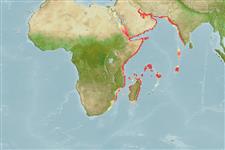>
Callionymiformes (Dragonets) >
Callionymidae (Dragonets)
Etymology: Callionymus: Greek, kallion, comparative of kallos = beautiful + Greek, onyma = name; with a better name .
More on author: Regan.
Environment: milieu / climate zone / depth range / distribution range
Écologie
marin démersal; profondeur 22 - 107 m (Ref. 11441). Tropical
Western Indian Ocean: two subspecies recognized, one from the southern Persian Gulf and the Gulf of Oman to Pakistan, and the other from the western and southeastern coasts of India.
Taille / Poids / Âge
Maturity: Lm ? range ? - ? cm
Max length : 16.0 cm TL mâle / non sexé; (Ref. 11441)
Description synthétique
Clés d'identification | Morphologie | Morphométrie
Épines dorsales (Total) : 4; Rayons mous dorsaux (Total) : 9; Épines anales: 0; Rayons mous anaux: 8.
Found on sandy and muddy bottoms (Ref. 48636).
Life cycle and mating behavior
Maturities | Reproduction | Spawnings | Egg(s) | Fecundities | Larves
Randall, J.E., 1995. Coastal fishes of Oman. University of Hawaii Press, Honolulu, Hawaii. 439 p. (Ref. 11441)
Statut dans la liste rouge de l'IUCN (Ref. 130435)
Menace pour l'homme
Harmless
Utilisations par l'homme
Outils
Articles particuliers
Télécharger en XML
Sources Internet
Estimates based on models
Preferred temperature (Ref.
123201): 22.5 - 28.1, mean 25.4 °C (based on 112 cells).
Phylogenetic diversity index (Ref.
82804): PD
50 = 0.5000 [Uniqueness, from 0.5 = low to 2.0 = high].
Bayesian length-weight: a=0.00912 (0.00408 - 0.02036), b=2.77 (2.59 - 2.95), in cm total length, based on LWR estimates for this Genus-body shape (Ref.
93245).
Niveau trophique (Ref.
69278): 3.3 ±0.4 se; based on size and trophs of closest relatives
Résilience (Ref.
120179): Haut, temps minimum de doublement de population inférieur à 15 mois (Preliminary K or Fecundity.).
Fishing Vulnerability (Ref.
59153): Low vulnerability (10 of 100).
